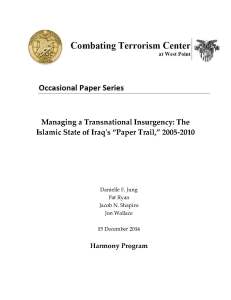This occasional paper contributes to the development of an empirically grounded understanding of the Islamic State by analyzing the finances and management of the group’s predecessor, the Islamic State of Iraq (ISI), which changed its name to the Islamic State in Iraq and the Levant (ISIL) in April 2013 and then the Islamic State in June 2014. There is a direct line of descent from al-Qa’ida in Iraq (AQI) through the ISI to today’s Islamic State, despite changes in the group’s territorial holdings and the announced scale of its ambitions.
The paper describes key findings of a joint research project between the CTC and the Empirical Studies of Conflict Project (ESOC) at Princeton. Over the last year, a team led by ESOC scholars in consultation with a wide range of subject matter experts analyzed over 150 newly-declassified insurgent documents, which range from spreadsheets listing the qualifications of hundreds of fighters to internal correspondence outlining geographic areas of responsibility for sub-units, organizational changes, and management reports of all kinds.
This effort represents the largest amount of declassified documents the CTC has ever released at one time in its 12-year history. AQI and the ISI produced the vast majority of the documents between 2005 and 2010. The documents were captured by U.S. and Iraqi forces during that period and were recently declassified under the auspices of the CTC’s Harmony Program.
Originals and translations of all the documents analyzed for this occasional paper are available below.
 Skip to content
Skip to content

